For outdoor cooking success, you'll want pot handles that can withstand high temperatures while providing a secure grip. Thermoset compounds and silicone-coated handles offer excellent heat resistance up to 572°F (300°C), while wood handles provide natural insulation. Consider handles that meet EU12983-1 safety standards and feature non-slip texturing with ergonomic finger grooves for better control. Whether you're using a grill, solar cooker, or campfire, look for dishwasher-safe materials that maintain their integrity under repeated use. Regular maintenance and inspection will guarantee your handles stay safe and reliable. Let's explore the specific features that'll make your outdoor cooking both safer and more enjoyable.
Best Heat-Safe Handle Materials

When choosing heat-safe pot handles, thermoset compounds offer the best combination of safety and durability. You'll find these materials excel in thermal resistance while providing superior mechanical strength for safe handling during outdoor cooking.
They're also dishwasher safe and maintain their integrity over time. Higher temperature thermoset handles are particularly suitable for professional-grade cookware that transitions between stovetop and oven.
Metal handles, particularly steel, are another reliable option if you're planning to use your pots in high-heat situations or the oven. However, you'll need potholders since metal conducts heat.
For better insulation, look for handles made from wood or composite materials that naturally resist heat transfer. You can also opt for coated handles with silicone covers, which provide excellent grip and additional heat protection.
If you're environmentally conscious, sustainable thermoset options now combine natural materials while reducing resource consumption.
Handle Temperature Testing Methods
Testing protocols for heat-safe pot handles combine rigorous laboratory analysis with real-world simulations to guarantee your safety.
You'll find thermal labs conducting standardized tests like the EU's resistance to burning and the US assembly strength tests at 350°F, using precise temperature verification equipment and thermal imaging cameras.
Field heat stress analysis puts handles through their paces with 15,000 cycles of up-and-down movements and various mechanical stresses to mirror actual cooking conditions. Additional testing employs Iwatani butane burners to evaluate handle performance under intense heat exposure.
Thermal Lab Testing Protocols
To guarantee consumer safety and regulatory compliance, thermal lab testing protocols for pot handles follow rigorous scientific methods.
You'll need proper temperature chambers and thermal probes to conduct accurate measurements during testing procedures.
Start by preparing your sample handles with clean, uniform surfaces and appropriate insulating barriers. Modern thermal testing embraces evolving sensor technologies for enhanced data precision and analysis.
During testing, you'll run multiple assessments including resistance to burning, heat resistance in ovens, and torque resistance to verify structural integrity.
Use thermocouples to collect real-time data while monitoring temperature distribution across the handle.
Don't forget to maintain detailed compliance records of your testing procedures.
You'll need to document all temperature measurements, heat penetration data, and process schedules.
Your records should demonstrate that handles meet safety regulations and can withstand both direct heat exposure and prolonged use without compromising user safety.
Field Heat Stress Analysis
Building on rigorous lab protocols, field heat stress analysis offers real-world validation of pot handle safety.
You'll need to measure multiple environmental factors that affect handle temperatures during outdoor cooking. Using tools like the Kestrel 5400 WBGT Heat Stress Tracker, you can monitor ambient temperature, humidity, and radiant heat from your cooking source.
Track how different cooking conditions impact handle performance by documenting temperature variations under direct sunlight versus shade.
You'll want to evaluate air movement around your cooking area, as wind can affect both cooling rates and heat distribution. Set up real-time monitoring via Bluetooth to record temperature fluctuations throughout the cooking process.
Remember to test handles under various activity levels, as rapid cooking movements can influence heat transfer and user comfort.
Safety Standards for Outdoor Handles
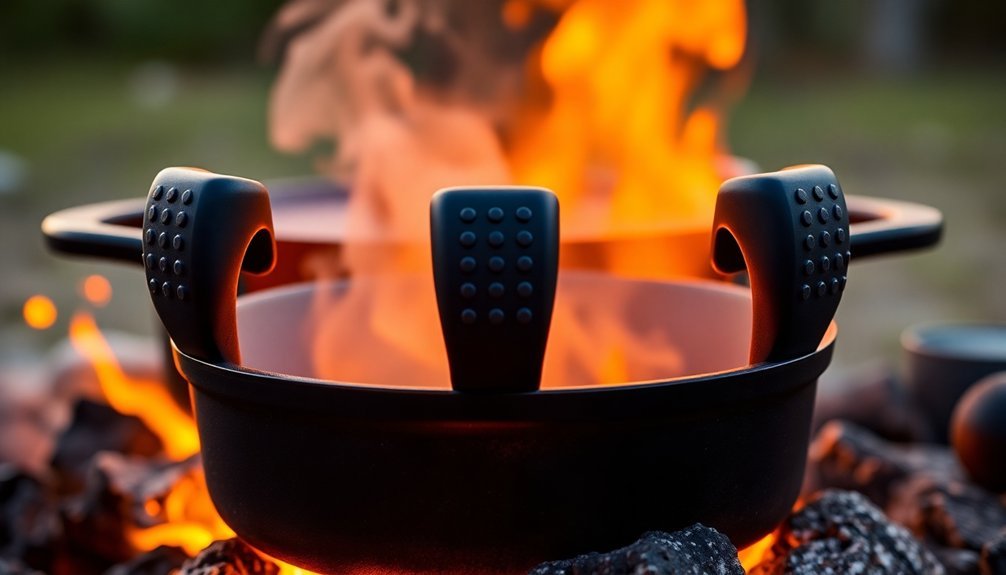
Safety regulations for outdoor pot handles demand rigorous standards beyond typical indoor cookware requirements.
You'll need handles that meet or exceed EU12983-1 guidelines, as outdoor cooking often involves higher temperatures and harsher conditions than indoor use.
When selecting outdoor pot handles, look for materials like thermoset plastic or silicone that can withstand temperatures up to 220°C.
These materials offer excellent insulation and won't transfer heat to your hands.
You'll want handles that have passed extensive durability tests, including resistance to dishwasher cycles and constant heat exposure.
Make certain your handles are approved by safety committees and manufactured using advanced injection technology.
This guarantees they'll maintain their strength and heat resistance even with repeated outdoor use.
Ergonomic Grip Design Tips
When you're cooking for extended periods, you'll want pot handles with ergonomic grips that prevent hand fatigue and maintain comfort throughout the process.
Your handles should feature non-slip texturing and contoured surfaces that naturally guide your hand into the safest holding position.
Look for handles with strategically placed finger grooves and thermally insulated materials that let you maintain a secure grip even during long cooking sessions.
Comfort During Long Cooks
Since extended cooking sessions can strain your hands and wrists, choosing a pot with an ergonomically designed handle is essential for comfort.
You'll want to select handles that accommodate both power and pinch grips, allowing you to adjust your hold as needed during long cooking sessions.
Look for handles made from wood or quality thermoset materials, as they'll provide better insulation and grip than smooth metal.
They should be sized to fit different hand sizes and feature rounded edges to prevent discomfort.
During lengthy cooking sessions, you'll appreciate handles that maintain a comfortable temperature and offer stable control of your cookware.
The best designs will let you shift between grip types easily while maintaining proper control, whether you're simmering a stew for hours or preparing multiple courses.
Secure Non-Slip Features
To prevent accidents in the kitchen, your pot handles must feature secure non-slip designs that maintain a firm grip even with wet or oily hands. You'll want handles made from thermoset plastic or compound rubber, materials that provide excellent insulation and grip properties.
| Feature | Benefit |
|---|---|
| 30-50mm diameter | Ideal width for power grip |
| 120mm length | Reduces palm fatigue |
| Textured surface | Prevents slipping |
| Non-glossy finish | Improves grip control |
Look for handles with textured surfaces that don't require excessive gripping force. They should be at least 4 inches long and feel comfortable in your palm without sharp edges. Choose handles that meet EU12983-1 safety standards, ensuring they'll perform reliably under high temperatures. You'll appreciate this extra security during lengthy cooking sessions.
Wood Vs Thermoset Handles
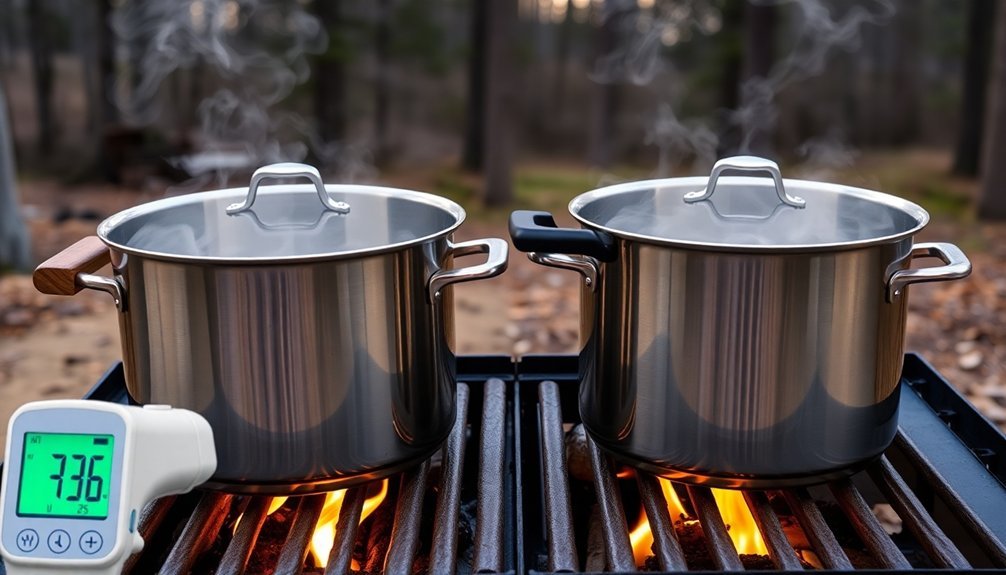
Although both wood and thermoset handles serve the same basic purpose, they offer distinct advantages that appeal to different users.
You'll find wood handles excel in thermal insulation and provide a comfortable, secure grip even when your hands are wet or greasy. They're also aesthetically pleasing and can be customized to fit your grip preferences.
If you're looking for low-maintenance options, thermoset handles might be your better choice. They're waterproof, hygienic, and won't absorb bacteria like wooden handles can.
You won't need to worry about moisture damage or frequent maintenance, making them ideal for humid environments. While wood brings traditional charm and natural insulation, thermoset handles offer practical benefits in durability and cleanliness.
Your choice should depend on your specific cooking environment and maintenance preferences.
Handle Maintenance in Harsh Weather
Maintaining your pot handles in harsh weather builds upon the durability advantages we discussed with wood and thermoset materials.
You'll need to pay extra attention to your handles when they're exposed to extreme conditions.
For silicone and thermoset handles, you can simply wipe them clean with warm water and inspect them regularly for signs of wear.
If you're using leather handles, apply conditioning treatment periodically to prevent cracking and maintain their heat resistance.
Don't forget to check for UV damage, especially if your cookware is stored outdoors.
Regular maintenance should include testing the grip stability and anti-slip features.
If you notice any loosening or deterioration in the handle's texture, it's time to address these issues.
Remember that proper cleaning and sanitization will extend your handles' lifespan and guarantee safe outdoor cooking.
Solar Cooking Handle Requirements
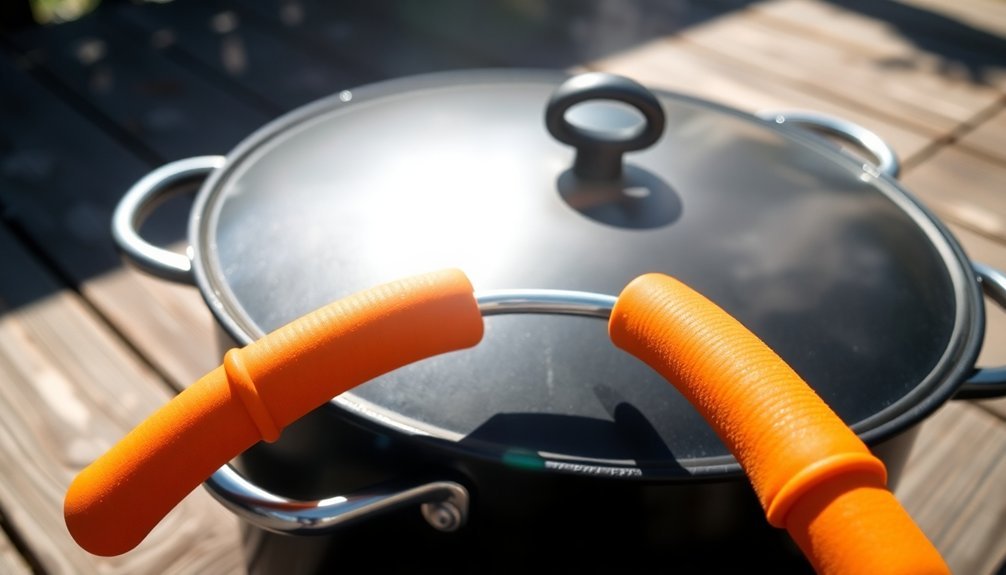
When choosing handles for solar cooking, you'll need materials that can withstand temperatures up to 350°F (177°C) for extended sun exposure, making metal and silicone ideal choices.
You'll get better performance from handles with reflective surfaces, as they deflect heat and stay cooler during long cooking sessions.
Your handles should also feature protective coatings or treatments to prevent degradation from UV rays and intense sunlight.
Temperature Thresholds For Sun
Since solar cookers can reach temperatures up to 800°F (427°C) in parabolic designs, pot handles must withstand extreme heat exposure while remaining safe to touch.
You'll need handles that can endure sustained temperatures of at least 400°F (204°C) for box-style ovens and even higher for parabolic models.
When you're cooking during peak hours between 11 am and 3 pm, your handles should maintain their structural integrity at temperatures well above the minimum cooking threshold of 180°F (82°C).
Since you'll need to adjust your cooker every 30 minutes to track the sun, it's essential to have handles that won't soften or degrade under intense UV exposure.
Remember that dark-colored cookware absorbs more solar energy, so your handles must be specially designed to stay cool despite the pot's high heat absorption.
Materials For Extended Exposure
Because solar cooking handles face constant exposure to intense heat and UV radiation, they require specialized materials that can endure extreme conditions while keeping your hands safe. You'll need to select materials that combine durability with effective heat resistance.
| Material Type | Heat Resistance | Best Applications |
|---|---|---|
| Stainless Steel | Up to 800°F | Primary handle structure |
| Silicone Coating | Up to 600°F | Grip enhancement |
| Ceramic Insulation | Up to 2000°F | Heat barrier |
| Fiberglass Core | Up to 1000°F | Internal insulation |
For ideal safety, you'll want to use a multi-layered approach: a strong metal core with heat-resistant coatings and insulation. Choose handles with textured surfaces and ergonomic designs that incorporate non-slip features. Don't forget to add protective elements like silicone grips or ceramic spacers to maintain a safe handling temperature.
Reflective Surface Benefits
While handles are essential for pot safety, the reflective surfaces around them play an important role in maximizing your solar cooker's efficiency.
You'll want to verify that these surfaces remain clean and shiny to concentrate the sun's rays effectively onto your cooking vessel.
The geometry of your reflective panels matters greatly. Curved or parabolic surfaces will focus sunlight more intensely than flat ones, helping you achieve higher temperatures.
You'll find that multiple reflector panels positioned correctly around your pot will enhance heating speed and reduce cooking time. Remember to adjust these panels throughout the day as the sun moves to maintain ideal heat concentration.
Keep shadows off your reflective surfaces and regularly clean them to maintain peak performance.
Dull or dirty surfaces won't concentrate sunlight effectively, which can compromise your cooking results.
Heat Resistance Ratings Explained
Understanding heat resistance ratings is essential when selecting pot handles for your cookware. You'll need to take into account both short-term and continuous exposure limits to guarantee safety and durability. Different materials offer varying levels of heat protection, with some better suited for high-temperature cooking than others.
| Material Type | Maximum Heat Rating |
|---|---|
| Plasti Dip | 200°F (93°C) |
| F.B.M. Standard | 300°F (150°C) |
| Polyolefin | 320°F (160°C) |
| Silicone | 572°F (300°C) |
| Luxury Grade | 425°F (220°C) |
While these ratings provide a general guide, you'll want to test materials before relying on them fully. Remember that short-term exposure limits don't guarantee safety during prolonged use. For outdoor cooking, it's best to choose materials rated well above your expected cooking temperatures to maintain a safe margin.
Stainless Steel Handle Properties

Thanks to their exceptional durability and versatile properties, stainless steel handles remain a top choice for high-quality cookware.
You'll appreciate their resistance to corrosion, thanks to a protective chromium oxide layer that maintains integrity even in humid conditions. While they're heavier than plastic alternatives, their professional appearance and lasting shine make them worth the investment.
- They're non-magnetic, making them perfect for use near electronic devices or in precision cooking environments
- The chromium content (minimum 10.5%) creates a protective barrier against rust and deterioration
- You'll get a consistently bright, modern aesthetic that enhances your cookware's appearance
- Though they're more expensive than plastic handles, their durability and heat resistance justify the cost
Watch out for environments with high chloride content, as this can lead to pitting corrosion over time.
Durability Under Extreme Conditions
When exposed to extreme conditions, heat-safe pot handles prove their exceptional resilience through rigorous testing and superior material composition.
You'll find these handles undergo extensive stress testing at temperatures exceeding 425°F/220°C, surpassing standard EU guidelines for safety assurance.
The durability of materials like thermoset plastic, high-temperature composites, and Bakelite guarantees your handles won't fail during intense cooking sessions.
They're designed to maintain structural integrity while preventing heat transfer to your hands. You can confidently move your cookware from stovetop to oven, knowing the handles have been tested beyond regulatory requirements.
Whether you're cooking in a professional kitchen or over a campfire, these handles maintain their performance through constant use, high-temperature exposure, and even dishwasher cleaning cycles.
Handle Attachment Systems
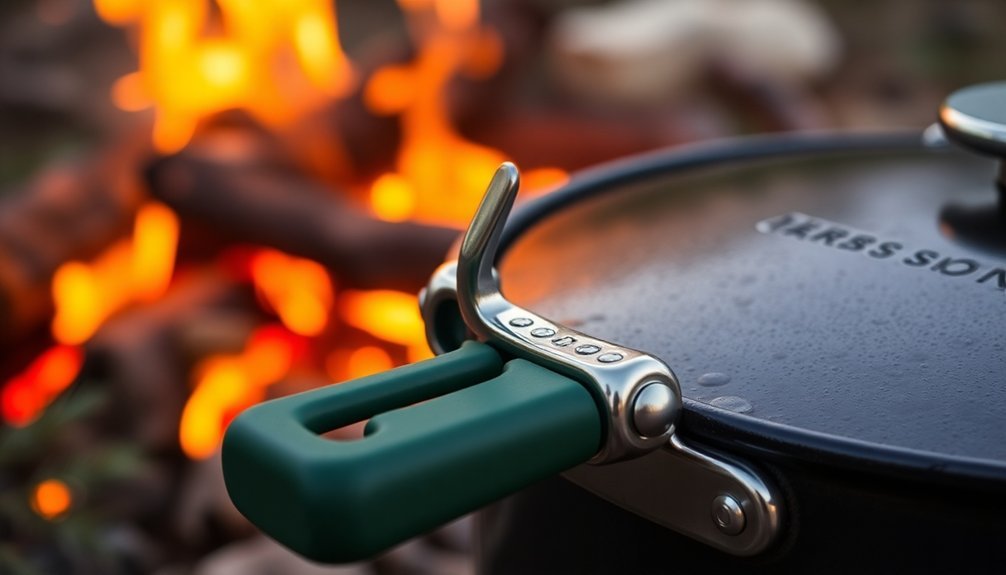
Secure handle attachment systems form the backbone of safe and reliable cookware performance.
When you're selecting outdoor cookware, you'll want to confirm the handles feature innovative fixing methods that prevent loosening during intense use and high temperatures.
Here's what makes a handle attachment system truly dependable:
- High-quality injection processes that create a seamless bond between thermoset handles and cookware base
- Built-in heat dissipation gaps that minimize thermal transfer from pot to handle
- Mechanical resistance features that maintain stability under heavy loads
- Dishwasher-safe connections that won't deteriorate with repeated cleaning
Look for handles that undergo rigorous torque and weight testing to verify their stability.
The best systems will maintain their integrity even when you're lifting fully loaded pots or cooking at high temperatures.
Customizing Handles for Performance
Great performance in heat-safe pot handles depends on customizing key design elements to match specific cooking needs.
When you're selecting handles for your cookware, consider both the materials and ergonomic design that'll best serve your cooking style.
You'll want to choose thermoset plastic or silicone handles for high-temperature cooking, as they'll maintain their cool-touch properties up to 220°C.
If you're using pots frequently, look for handles that've been tested beyond EU12983-1 standards. The grip should feel natural in your hand and provide stable control during use.
For professional cooking, opt for handles that are dishwasher-safe and can withstand rigorous sanitization.
Remember that the handle's size, shape, and weight should complement your cooking movements while ensuring safety and comfort throughout extended use.
Frequently Asked Questions
Can Campfire Soot Permanently Stain or Damage Heat-Resistant Handles?
Yes, if you don't clean soot promptly, it can permanently stain and damage your heat-resistant handles. You'll need to remove it quickly and use appropriate cleaning methods to protect the handle's surface.
How Do Electromagnetic Induction Cooktops Affect the Safety of Heat-Resistant Handles?
When you're using induction cooktops, EMF radiation can conduct through metal handles. You'll want to choose pots with non-conductive handles or use insulated covers to protect yourself from unwanted EMF exposure while cooking.
Does Altitude Affect the Heat Resistance Capabilities of Pot Handles?
No, altitude won't affect your pot handle's heat resistance capabilities. The material properties and heat-resistant features of your handles remain consistent regardless of elevation – it's more about the material and design choices.
Are Glow-In-The-Dark Handle Materials as Heat Resistant as Standard Ones?
You'll find that glow-in-the-dark handles typically aren't as heat resistant as standard ones. They often contain phosphorescent materials that can degrade at high temperatures, making them less suitable for high-heat cooking applications.
Can Handles Be Retrofitted With Additional Insulation After Prolonged Use?
Yes, you can retrofit your handles with additional insulation like heat-shrink wrap or silicone covers even after extended use. You'll need to clean the handle thoroughly first to guarantee proper adhesion.
In Summary
You'll find the right heat-safe handles are essential for safe and enjoyable outdoor cooking. Whether you choose wood, thermoset, or stainless steel, make sure to test your handles' heat resistance and check their safety certifications. Don't forget to take into account the grip design and attachment method that works best for your cooking style. With proper handle selection, you'll be ready to tackle any outdoor cooking adventure.

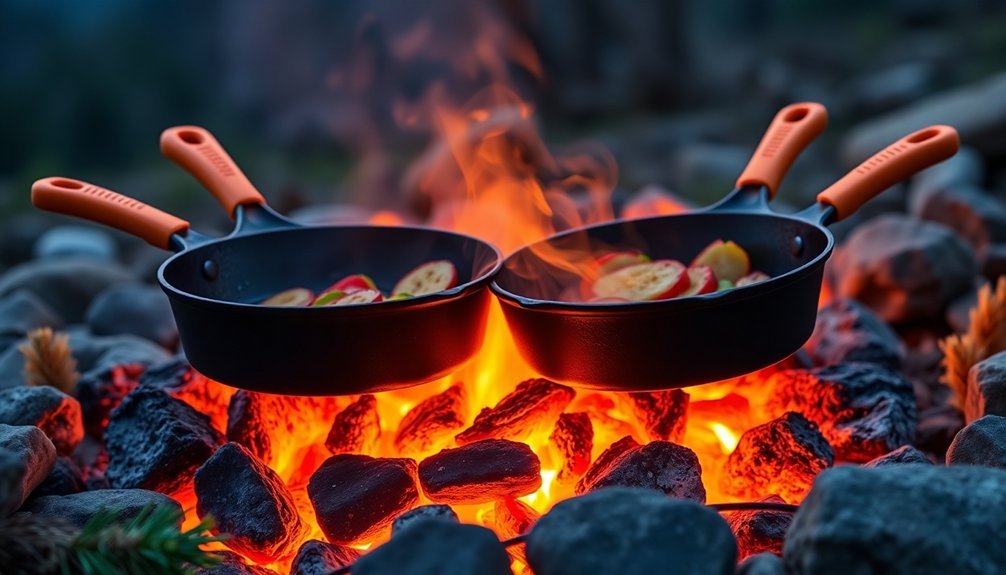



Leave a Reply